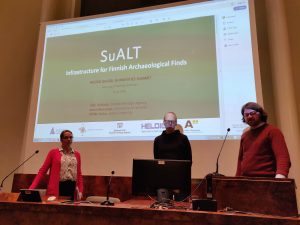A new article by SuALTers Anna Wessman, Suzie Thomas and Ville Rohiola was recently published as an open access article in the SKAS journal. It will also appear as a paper version in Volume 1/2019.
The article introduces the goals of our project as well as our upcoming database FindSampo for a Finnish audience for the first time. The article also discusses citizen science in Finnish archaeology, a topic that has been neglected so far.
In recent years, metal-detecting has showed its potential in broadening and enlarging our archaeological knowledge with both new material and information.
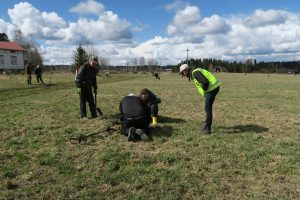
Engaging with metal-detectorists. Photo: Anna Wessman
By understanding metal-detecting as a form of citizen science, professional archaeologists may find new ways to collaborate with the public in a reciprocal manner.
FindSampo will be a platform were detectorists record their finds into the system on their own, which makes SuALT a collaborative citizen science initiative. We are trying to interact with the public in an inclusive way instead of merely looking at detectorists as volunteers. When members of the public produce new data side by side with professional archaeologists, it also provides new opportunities for collaboration.
The educational aspect of FindSampo
At the time when FindSampo is up and running, it will have several end-users: the public, researchers and cultural heritage authorities. This puts many challenges on the project team. How will we be able to suit all the diverse and even contradictory need of our users? Our goal is to develop a platform that is easy to use by adding enough information and tutorials. These could include training videos on how to take measurements on-site, how to take proper photographs, how to handle the objects and so on. Naturally, map layers of protected ancient sites should be added in order to avoid violations against the Antiquities Act. Thus, the educational aspects of FindSampo are a priority.
Another important aspect with FindSampo is that it will offer an important tool for the Finnish Heritage Agency (FHA) to manage information and processes dealing with archaeological finds made by public. FindSampo’s interoperability with the FHA’s existing databases is essential. We achieve this by relying on the use of ontology, a work that is still in progress. Ontology is necessary to record accurate find information, but also in order to use the database as a detailed search tool and for academic research. At the same time, ontology enables the finds data to be more interoperable with other databases, including international databases, such as PAN, PAS, Medea and DIME.
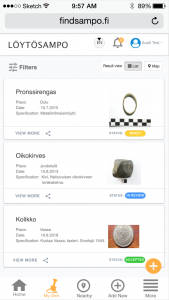
Design: Pejam Hassanzadeh/SuALT project
One of the goals of FindSampo is to capture archaeologically sensitive data found by metal-detectorist that would otherwise be lost. We feel that all finds over 100 years of age, which is currently not reported by everyone, has an enormous potential to reveal important information about Finland’s archaeological past. In this way we are able to conserve knowledge of also ‘modern’ finds. By recording ‘everything’ into FindSampo we will support also future academic research.
One of the challenges for SuALT is to engage the public, especially the heterogeneous crowd of metal- detectorists to be active and continuous users of the service. One way of doing this is to provide the users with a personalized view to the application and provide a platform for interaction with others possible, which makes engagement with FindSampo more rewarding. Another way of providing information through the platform could be short but informative info boxes about finds. These could be ‘object of the month’ information boxes, which would provide information about the most common find categories made by detectorists. In time, this would grow into a large information bank that would function also as an educational tool for beginners to the hobby.
Digitaalinen arkeologia ja kansalaistiede – uusi artikkeli SuALT-projektilta
Suomen Keskiajan Arkeologian seuran SKAS-lehdessä on juuri julkaistu SuALT-projektin artikkeli. Sen ovat kirjoittaneet Anna Wessman, Suzie Thomas ja Ville Rohiola. Artikkeli on saatavilla jo sähköisenä, paperisena sen voi lukea pian SKAS-lehden numerosta 1/2019.
Artikkeli esittelee SuALT-projektin tavoitteiden lisäksi nyt ensimmäistä kertaa työn alla olevaa Löytösampo-tietokantaa. Lisäksi artikkeli käsittelee kansalaistiedettä, jota ei ole liiemmin käytetty vielä Suomen arkeologisessa tutkimuksessa.
Metallinetsintä on viime vuosina osoittanut, miten suuri mahdollisuus meillä on sen tarjoamilla tiedoilla laajentaa käsitystämme arkeologisesta kulttuuriperinnöstä. Kansalaistieteen keinoin arkeologien on mahdollista löytää uusia yhteistyötapoja metallinetsinnän parissa, jossa vastavuoroisuus toimijoiden välillä on tärkeää.
Löytösampo tulee toimimaan sovelluksena, johon metallinetsinharrastajat ilmoittavat löytönsä itsenäisesti. Portaalin tarkoituksena on luoda alusta yhteistyölle, jossa arkeologian harrastajat ovat vuorovaikutuksessa ammattilaisten kanssa osallistavalla tavalla. Uusia yhteistyötapoja on mahdollista kehittää, kun kansalaiskäyttäjät tuottavat löytötietoja rinnatusten arkeologien kanssa.

Metallinetsinharrastus on kansalaistiedettä. Kuva: Anna Wessman.
Löytösampo koulutusvälineenä
Löytösampoa tulevat käyttämään useat eri tahot: suuri yleisö, tutkijat sekä viranomaiset. Haasteena on, miten pystymme vastaamaan käyttäjien erilaisiin ja jopa ristiriitaisiin tarpeisiin. Tavoitteena on kehittää nettiportaali, joka on helppokäyttöinen. Sen käyttäjäystävällisyyttä pyritään parantamaan erilaisten oppaiden ja tietopakettien avulla. Ne voivat sisältää koulutusvideoita esimerkiksi löytöpaikalla tehtävistä mittauksista, laadukkaiden valokuvien ottamisesta sekä löytöjen asianmukaisesta käsittelystä. Erilaisten karttatasojen avulla on tarkoitus luoda mahdollisimman hyvä perusta metallinetsinnälle. Nähtävillä ovat mm. Muinaismuistolain (295/1963) suojelemat muinaisjäännöskohteet, jotka pitää huomioida maastossa toimiessa.
Tärkeää on myös se, että Löytösampo tarjoaa Museovirastolle työkalun kansalaisten tekemien löytöjen ja niitä koskevien tietojen käsittelyyn. Löytösampo tulee linkittymään Museoviraston tietojärjestelmien kanssa. Järjestelmien yhteistoiminnallisuudessa ontologialla on tärkeä rooli. Sen kautta eri tietokannat puhuvat asioista samoin käsittein ja tiedon liikkuminen on sujuvaa. Ontologian käyttö on tästä syystä tärkeää löytötiedon tallentamisessa. Ontologiatyö arkeologisen esineistön osalta on tällä hetkellä käynnissä. Ontologia takaa myös toimivan hakutyökalun, josta on suuri apu esimerkiksi tieteelliselle tutkimukselle. Lisäksi ontologian avulla pystytään luomaan yhteistoiminnallisuus kansainvälisten tietokantojen kanssa. Vastaavanlaisia tietokantoja Löytösammon kanssa ovat mm. PAN, PAS, Medea ja DIME.

Myös hiukan uudemmat esineet voidaan ilmoittaa Löytösampoon. Kuva: Anna Wesssman
Yksi projektin tavoitteista on, että Löytösampoon tallennettaisiin myös arkeologisesti arkaa aineistoa, joka muuten katoaisi. Harrastajat eivät aina ilmoita kaikkia löytämiään yli 100 vuotta vanhoja esineitä. Kaikki löydöt ovat kuitenkin merkityksellisiä. Ne voivat sisältää tärkeätä tietoa Suomen arkeologisesta menneisyydestä. Löytösammon avulla voimme säilyttää tiedon myös ‘nykyaikaisista’ löydöistä ja tallentamalla ‘kaiken’ tuemme myös akateemista tutkimusta.
Yhtenä projektin haasteena on saada kansalaiset, etenkin moninainen metallinetsijöiden joukko käyttämään portaalia aktiivisesti. Tavoitteena on tarjota käyttäjille ominaisuuksia, jotka kannustavat käyttämään sitä. Sellaisia voisivat olla esimerkiksi käyttäjäkohtainen näkymä tai vuorovaikutusmahdollisuuksien lisääminen. Sovelluksen käyttäjäystävällisyyttä voisivat lisätä myös lyhyet, mutta informatiiviset tietoiskut löydöistä, kuten ’kuukauden esine’ -tyyliset nostot. Ne voisivat sisältää tietoa esimerkiksi yleisimmistä metallinetsinlöydöistä. Ajan kuluessa tietoiskuista koostuisi aineisto, jota voitaisiin käyttää esimerkiksi metallinetsinnästä kiinnostuneiden koulutuksessa.





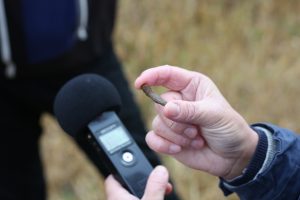
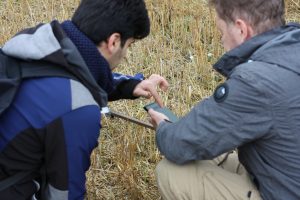





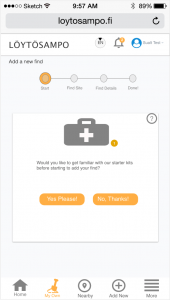
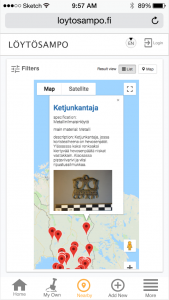
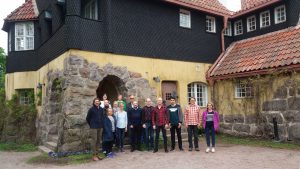
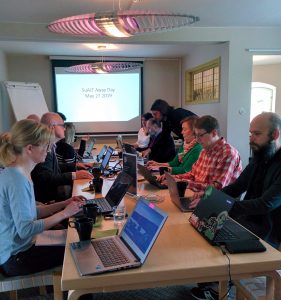
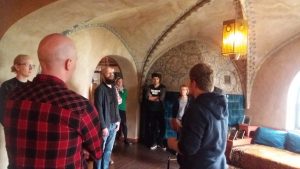
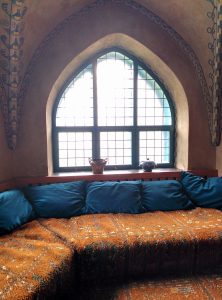
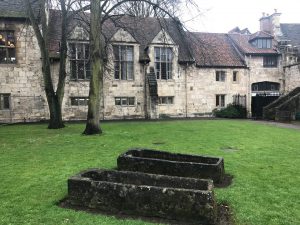
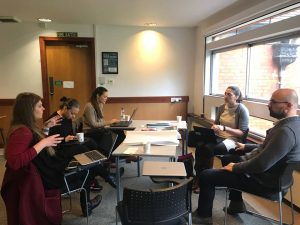


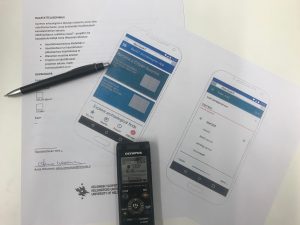
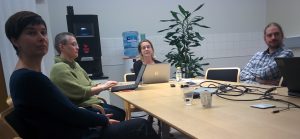


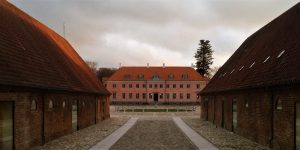
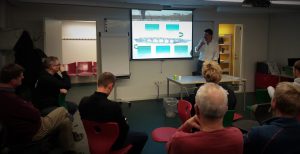


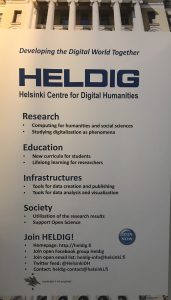 The
The 